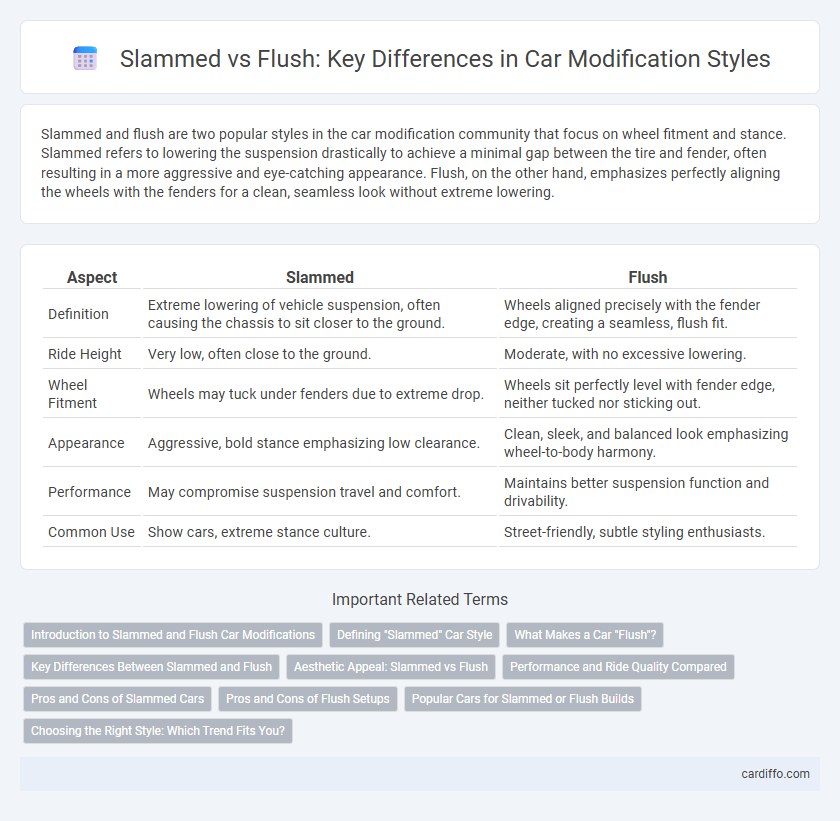Slammed and flush are two popular styles in the car modification community that focus on wheel fitment and stance. Slammed refers to lowering the suspension drastically to achieve a minimal gap between the tire and fender, often resulting in a more aggressive and eye-catching appearance. Flush, on the other hand, emphasizes perfectly aligning the wheels with the fenders for a clean, seamless look without extreme lowering.
Table of Comparison
| Aspect | Slammed | Flush |
|---|---|---|
| Definition | Extreme lowering of vehicle suspension, often causing the chassis to sit closer to the ground. | Wheels aligned precisely with the fender edge, creating a seamless, flush fit. |
| Ride Height | Very low, often close to the ground. | Moderate, with no excessive lowering. |
| Wheel Fitment | Wheels may tuck under fenders due to extreme drop. | Wheels sit perfectly level with fender edge, neither tucked nor sticking out. |
| Appearance | Aggressive, bold stance emphasizing low clearance. | Clean, sleek, and balanced look emphasizing wheel-to-body harmony. |
| Performance | May compromise suspension travel and comfort. | Maintains better suspension function and drivability. |
| Common Use | Show cars, extreme stance culture. | Street-friendly, subtle styling enthusiasts. |
Introduction to Slammed and Flush Car Modifications
Slammed and flush car modifications are popular styles that enhance a vehicle's stance and aesthetics by lowering its ride height and aligning the wheels with the fenders. Slammed cars feature an aggressive drop, often achieved through coilovers or air suspension, creating a pronounced gap reduction between the tires and wheel arches. Flush setups prioritize precise wheel fitment with minimal offset, ensuring the wheels sit perfectly aligned with the body panels for a sleek and clean appearance.
Defining "Slammed" Car Style
A slammed car style refers to a vehicle lowered significantly close to the ground, often achieved through aftermarket suspension modifications to reduce the wheel gap and improve aesthetics. Unlike a flush setup where the wheels align perfectly with the fenders, slammed cars emphasize an aggressive, ultra-low stance that can affect ride quality and practicality. This modification is popular in car culture for its striking visual impact and customized look.
What Makes a Car "Flush"?
A car is considered "flush" when its wheels align precisely with the fender, creating a smooth and seamless profile without any tire poke or tuck. This look is achieved through careful adjustment of wheel offset, suspension height, and sometimes camber, ensuring the tire sits evenly within the wheel well. Flush fitment optimizes both aesthetics and function, providing a clean stance while maintaining proper tire clearance and suspension travel.
Key Differences Between Slammed and Flush
Slammed vehicles feature significantly lowered suspension, often causing the wheels to tuck under the fenders, creating aggressive ride height changes and enhanced stance. Flush setups align the wheels evenly with the fender lip, offering a sleek appearance without excessive lowering, balancing aesthetics and drivability. Key differences between slammed and flush include the degree of suspension drop, wheel fitment relative to the fender, and overall ride comfort.
Aesthetic Appeal: Slammed vs Flush
Slammed refers to a vehicle lowered aggressively, often causing the wheels to tuck into the fenders, creating a bold and extreme aesthetic appeal popular in custom car culture. Flush describes a setup where the wheels align perfectly with the edge of the fenders, offering a sleek, clean, and balanced look that emphasizes harmony between tire and body. Both styles enhance visual impact but cater to different tastes: slammed for a dramatic stance and flush for a refined, streamlined appearance.
Performance and Ride Quality Compared
Slammed vehicles with extreme lowering can negatively impact suspension travel, leading to a harsher ride and reduced shock absorption, which compromises overall performance on uneven roads. Flush setups balance lowered aesthetics with functional suspension geometry, preserving ride quality and handling characteristics by maintaining proper wheel fitment and tire contact. Performance advantages of flush over slammed include better stability, improved cornering grip, and a more comfortable driving experience on everyday surfaces.
Pros and Cons of Slammed Cars
Slammed cars, characterized by their significantly lowered suspension, enhance overall aesthetics and improve cornering stability but often sacrifice ride comfort and increase the risk of undercarriage damage. This aggressive stance offers a unique visual appeal that automotive enthusiasts appreciate, yet it can lead to practical challenges such as tire wear and difficulty navigating speed bumps or uneven roads. Unlike flush setups, slammed vehicles prioritize visual impact over functional versatility, making them less ideal for daily driving conditions.
Pros and Cons of Flush Setups
Flush setups enhance aesthetic appeal by aligning the wheel rim perfectly with the fender, creating a sleek, seamless look favored in car customization. This configuration improves aerodynamics and reduces drag, potentially boosting fuel efficiency and handling at higher speeds. However, flush setups can increase tire wear and risk fender damage from road debris, requiring precise fitment and regular maintenance to avoid costly repairs.
Popular Cars for Slammed or Flush Builds
Slammed and flush builds are popular modifications in the automotive community, with cars like the Honda Civic, Volkswagen Golf, and BMW 3 Series frequently chosen for slammed setups due to their adaptability to lowered suspension and aggressive stance. Flush builds are commonly seen on vehicles such as the Mazda Miata, Subaru WRX, and Ford Mustang, where wheel fitment aligns perfectly with fender lines for a clean, sleek look. These modifications enhance aesthetics and performance, with slammed cars emphasizing extreme lowering and flush builds focusing on precise wheel-to-fender clearance.
Choosing the Right Style: Which Trend Fits You?
Choosing between slammed and flush styles depends on your desired stance and practicality; slammed involves extreme lowering with tires tucked aggressively, offering a bold, aggressive look but less everyday comfort. Flush style strikes a balance with wheels sitting evenly against the fender, providing a clean appearance and better drivability. Consider vehicle use, aesthetic preference, and suspension setup to determine which trend suits your lifestyle and automotive goals.
Slammed vs Flush Infographic

 cardiffo.com
cardiffo.com